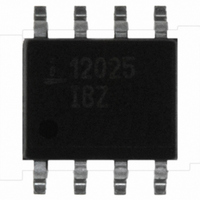ISL12025IBZ Intersil, ISL12025IBZ Datasheet - Page 21

ISL12025IBZ
Manufacturer Part Number
ISL12025IBZ
Description
IC RTC/CALENDAR EEPROM 8-SOIC
Manufacturer
Intersil
Type
Clock/Calendar/Supervisor/EEPROMr
Specifications of ISL12025IBZ
Memory Size
4K (512 x 8)
Time Format
HH:MM:SS (12/24 hr)
Date Format
YY-MM-DD-dd
Interface
I²C, 2-Wire Serial
Voltage - Supply
2.7 V ~ 5.5 V
Operating Temperature
-40°C ~ 85°C
Mounting Type
Surface Mount
Package / Case
8-SOIC (3.9mm Width)
Bus Type
Serial (I2C)
Operating Supply Voltage (typ)
3.3V
Operating Supply Voltage (max)
5.5V
Operating Supply Voltage (min)
2.7V
Operating Temperature Classification
Industrial
Operating Temperature (max)
85C
Operating Temperature (min)
-40C
Pin Count
8
Mounting
Surface Mount
Clock Format
HH
Clock Ic Type
RTC
Interface Type
I2C, Serial
Memory Configuration
512 X 8
Supply Voltage Range
2.7V To 5.5V
Digital Ic Case Style
SOIC
Rohs Compliant
Yes
Lead Free Status / RoHS Status
Lead free / RoHS Compliant
Application Section
Crystal Oscillator and Temperature Compensation
Intersil has now integrated the oscillator compensation
circuity on-chip, to eliminate the need for external
components and adjust for crystal drift over temperature and
enable very high accuracy time keeping (<5ppm drift).
The Intersil RTC family uses an oscillator circuit with on-chip
crystal compensation network, including adjustable
load-capacitance. The only external component required is
the crystal. The compensation network is optimized for
operation with certain crystal parameters which are common
in many of the surface mount or tuning-fork crystals available
today. Table 7 summarizes these parameters.
Table 8 contains some crystal manufacturers and part numbers
that meet the requirements for the Intersil RTC products.
The turnover temperature in Table 7 describes the
temperature where the apex of the of the drift vs temperature
curve occurs. This curve is parabolic with the drift increasing
as (T-T0)
turnover temperature is typically +25°C, and a peak drift of
>110ppm occurs at the temperature extremes of -40 and
+85°C. It is possible to address this variable drift by adjusting
the load capacitance of the crystal, which will result in
predictable change to the crystal frequency. The Intersil RTC
family allows this adjustment over temperature since the
devices include on-chip load capacitor trimming. This control
2
. For an Epson MC-405 device, for example, the
SIGNALS FROM
THE MASTER
SDA BUS
SIGNALS FROM
THE SLAVE
SIGNALS FROM
THE MASTER
SDA BUS
SIGNALS FROM
THE SLAVE
21
S
A
R
T
T
1
ADDRESS
SLAVE
ADDRESS
SLAVE
1
FIGURE 25. RANDOM ADDRESS READ SEQUENCE
1
A
C
K
FIGURE 26. SEQUENTIAL READ SEQUENCE
1
1
0
A
C
K
DATA
0 0 0 0 0 0 0
(1)
ADDRESS 1
WORD
ISL12025
A
C
K
A
C
K
ADDRESS 0
DATA
(2)
is handled by the Analog Trimming Register, or ATR, which
has 6-bits of control. The load capacitance range covered by
the ATR circuit is approximately 3.25pF to 18.75pF, in
0.25pF increments. Note that actual capacitance would also
include about 2pF of package related capacitance. In-circuit
tests with commercially available crystals demonstrate that
this range of capacitance allows frequency control from
+116ppm to -37ppm, using a 12.5pF load crystal.
In addition to the analog compensation afforded by the
adjustable load capacitance, a digital compensation feature
is available for the Intersil RTC family. There are 3-bits
known as the Digital Trimming Register or DTR, and they
operate by adding or skipping pulses in the clock signal. The
range provided is ±30ppm in increments of 10ppm. The
default setting is 0ppm. The DTR control can be used for
coarse adjustments of frequency drift over-temperature or
for crystal initial accuracy correction.
A final application for the ATR control is in-circuit calibration
for high accuracy applications, along with a temperature
sensor chip. Once the RTC circuit is powered up with battery
backup, and frequency drift is measured. The ATR control is
then adjusted to a setting which minimizes drift. Once
adjusted at a particular temperature, it is possible to adjust at
other discrete temperatures for minimal overall drift, and
store the resulting settings in the EEPROM. Extremely low
overall temperature drift is possible with this method. The
Intersil evaluation board contains the circuitry necessary to
implement this control.
WORD
A
C
K
(n IS ANY INTEGER GREATER THAN 1)
A
C
K
S
T
A
R
T
1
ADDRESS
DATA
(n - 1)
SLAVE
1
1
1
1
A
C
K
A
C
K
DATA
DATA
(n)
S
O
P
T
O
S
T
P
August 13, 2008
FN6371.3








